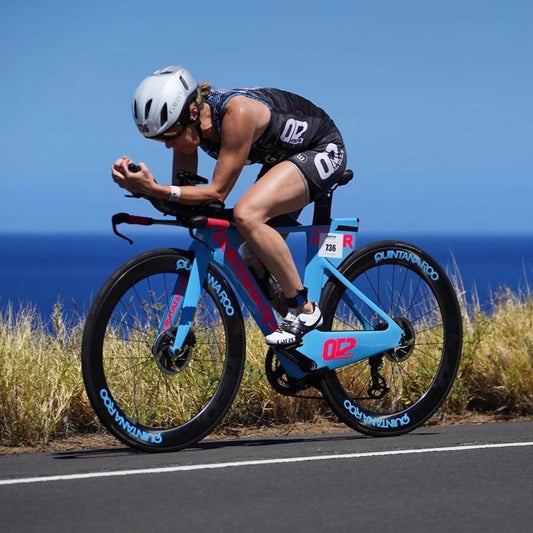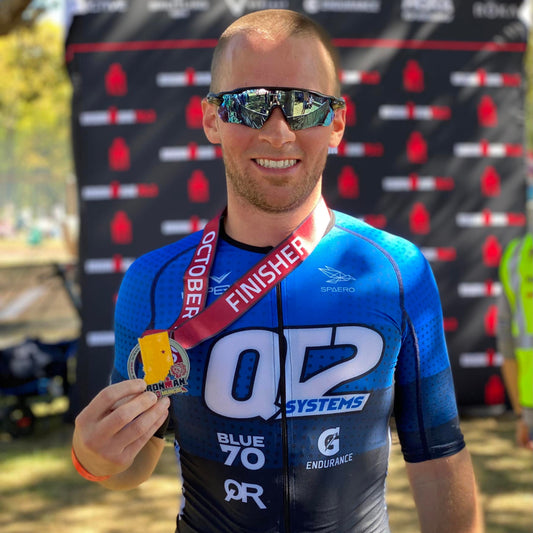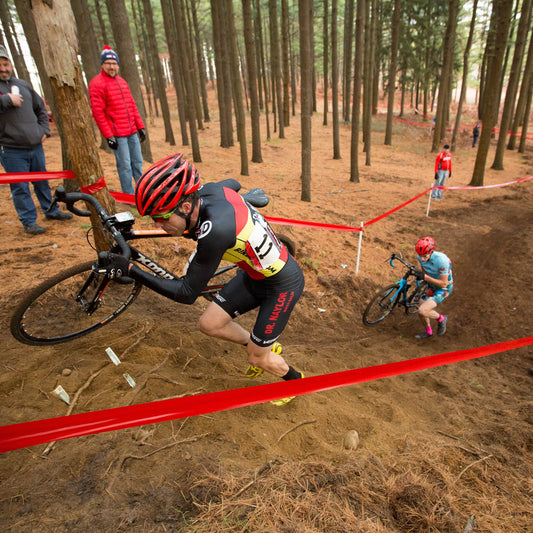
When working through injuries, I’ve often found myself drawing parallels between the lessons learned throughout the comeback process with the lessons I’ve learned from a decade of racing Ironmans (or any shorter races, IMs are just most relatable to me because of the concept of “the long haul”). Those initial acute stages, they’re sort of like the swim (well, at least if you’re very much a land mammal who *might* prefer a little bike/run, such as yours truly). If something is planned (aka, a surgery) there are nerves, but also anticipation and eagerness to get the process started. The swim start (at least for me, someone who typically flails around trying to sprint and catch ANY feet) is akin to the time period right after an injury peaks pain-wise. It might not last long, but it’s a struggle of just trying to hang on, and get yourself onto the right path. Once more settled, the rest of the swim typically passes similarly to the first few weeks of injury-you catch your breath, assess the situation you’ve landed in, and realize that you’re in it for the haul. That time period where treatment and recovery shifts from purely decreasing pain and calming inflammation to starting to move and load structures is like T1-the real acute stuff is over, but much lies ahead. And while the dividing line between “actively injured” and “coming back” might not be as clear-cut as T1, some truths and similarities exist between working through a race and coming back from an injury-so let’s delve further into it!
Nothing will be linear.
In both triathlon training and racing, nothing ever goes exactly according to plan. Ideally, every workout gets ticked off, fitness gains come steadily, and come race day, race plans go accordingly. But does this ever really happen? Maybe very occasionally, but it’s certainly the exception, not the rule. Life comes up, bodies get fatigued, workouts get altered, and maybe race day is windy or hot or cold, or a bike mechanical happens, and the race might end up taking longer than expected. So, pretty much a perfect analogy for injury healing and comebacks. Early on in my physical therapy career, I always struggled with the “how long will this take to heal?” question, because, to be honest, I didn’t have the confidence to admit, “it depends”. No matter what we learned about how the body works to heal and calcify bone, or how neatly post-operative protocols categorize healing into “at 8 weeks, you’ll do this, at 12 weeks, you’ll be here”, nothing every actually progresses this smoothly. On a PT podcast I listened to a few weeks ago, the host discussed how essentially, you might as well multiply protocol timelines by 1.5 times and set expectations that pain will persist and fluctuate longer than what seems logical at times. While hopefully a race won’t take 1.5 times longer than anticipated, the point reminds that the comeback (and racing) road will be more of a roller coaster than it feels like it should be at times.
You’ll figure out how to troubleshoot and not give up.
With that, don’t despair. When misfortune strikes while racing, it quickly becomes clear that shoving emotion aside, and approaching the problem practically, and keeping a level(ish) head is the best approach. At IM Coeur d’Alene years back, my front brake started rubbing my new race wheel. I spent some time with tech support, restarted, only to discover that, miles later when my speed still wasn’t matching up, the brake was still rubbing. So, I (disclaimer: I do not recommend this approach, but my rear brake DID stop the bike) did the only thing I could think of: stopped at the next aide station, unscrewed the brake shoe, and rode the remainder of the bike with 1.5 brakes. I lost ~25min and likely a podium spot due to the whole ordeal-but, I also turned in the fastest second loop of the bike and marathon in the women’s field, and, once the disappointment cleared, eventually became prouder of myself on that day than I have of any of my flashier results. While troubleshooting during a recovery process really shouldn’t involve throwing caution into the wind with semi-risky brake removal decisions, the point remains, part of getting to the comeback involves problem solving as you move along. That might involve switching up a rehab routine, temporarily substituting some running for swimming, adding in some bodywork, playing with run gait cadence-whatever it is, when the other option is giving up, you‘ll figure out ways to get through.
...and the sticking points make you appreciate the smooth-sailing times
Up until that day in Coeur d’Alene, in nearly four years of racing triathlons, I’d been pretty lucky to have never had a bike mechanical of any sort. And sure, I was always happy to get off the bike and hit the ground running, but it took a little struggle for me to really gain a sense of gratitude for making it through a bike leg without any sort of misfortune. The same thing goes for injury comebacks. Setbacks can sometimes be inevitable-something that felt more healed suddenly feels sore again, increases in run volume don’t go over so well, you trip and re-tweak that knee-but, at the end of it all, you’ll come to appreciate the stretches where healing is actually sort of progressing accordingly, and your body is in accordance with adding in training load.
The Physical Can Affect the Mental, but the Mental Can Get You Through the Physical
Sure, every race is hard, but when the miles are clicking away according to plan, desired paces are being hit, and goals are being achieved, staying mentally present and positive in order to push for success comes more easily than on those days when the body isn’t having it quite so much. While the flashy results and PRs get the most attention, as a coach, I’m always the proudest when athletes push through the mind over matter days to get the best result possible, even if wasn’t as planned. That, to me, is a true show of mental strength, which should be lauded more than physical strength. This is similar to the process of returning from an injury. Some days, pain levels are low, training load is being added, the body feels good, fitness is progressing, and moods are high. Others, the injury flares, something compensatory pops up, training load has to be pulled back, or fitness is stalled. Those are the days that require patience, toughness, and mental fortitude, and they’re the ones that will truly grow you as an athlete. Smooth sailing makes anyone happy, but navigating the rougher waters can also be embraced for the mental growth, as well.
Appreciating how far you’ve come and wishing you were further along are not mutually exclusive.
I do a lot of random mental math while training and racing, thinking in terms of fractions and percentages, dividing times and distances into smaller chunks in order to will myself along. Early on, those percentages pass quickly-I'm already through 1/10, 1/5, 1/4, 1/3 of this ride, that didn’t seem to take that long. As time progresses, sometimes my mindset subtly shifts-ok, I’m through 40% so that’s good, but ugh, that means that I still have 60% to go. While I might be glad that I’m through a good portion of the ride, I’d still like to have a greater percentage of that knocked off. To me, this is similar to the process of regaining fitness coming back from an injury. I’ll start swimming/biking/running, and initially be excited just to be back out there, moving again-like those early percentages. Not too long thereafter, though, the reality of current fitness levels, and how far I am from where I want to be sets in. Sure, I might be thrilled to be running again, but at the same time, struggling to run a minute per mile slower than where I was pre-injury can make that elusive fit, crisp, flowing training and racing seem light years away. But, the solution remains to keep plugging along, and incrementally keep chipping away.
You’ll have some mile 19 moments.
In every IM marathon that I’ve done, mile 19 proves to be a low point. My logical brain knows that in the great scheme of things, compared to what’s behind me, what’s ahead really isn’t that much-maybe 10% of the day time-wise or so, to go back to those percentages. But, in that moment, the logical brain is being superseded by the whiny, illogical brain, that is taking cues from a worn out body telling it that basically still has forever to go. I’ve run 7 miles countless times in countless conditions in my life, but 7 miles ago was only mile 12 which wasn’t even halfway through the marathon, and I juuuust want to be done, and everything hurts and I’m dying, and not really but I’m just over being out there and want to get to the feelings at the end. You get the picture. In every injury rehab I’ve gone through, I’ve had moments of all of these feelings-typically, 2-3 months down the line, when I’m pretty darn close to being able to run or train more full strength and plan, but something still hurts, I’m not there yet, I want the carrot at the end of the rope, my support system probably wants me to just be done, too, and the next 3-4 weeks (or whatever timeline) seem insurmountable. Those are the moments I draw on mile 19, where it just seems like it’s all going to go on forever, but, in reality, if I just put on the blinders and plug through a mile at a time, suddenly, what’s left is close, and I’m revived again. So, just keep going. The comeback is near.
Regardless of outcome, it WILL be worth it.
I’ve won an Ironman. I’ve also gotten lapped on run courses and finished close to last in the pro field on more than one occasion. And I’ve regretted exactly zero of those finishes. The nailed days are awesome, and the not-so-hot days have taught me myriads about what I’m able to endure. Plus, one of those not-so-hot days was followed by sampling every empanada in Argentina, so that alone made it worth it. When working back from injury, it’s natural to dream of a triumphant comeback, one complete with a great performance even by pre-injury standards. Sometimes, this does happen. Years back, after a nearly three-year hiatus from an IM finish with a crash and fractures and surgeries and a DNS thanks to a stomach bug during a trip to Australia to top it all off, I landed on the podium in Mont Tremblant, and that remains one of the highlights (if not THE highlight) of my triathlon career. The emotions of that day can’t be put into words. But, I’ve come back from long (year plus) layoffs in much less illustrious fashions plenty of times, finishing well back in the pro pack, far off of PRs. Yet still, each of those finishes meant just as much to me, all accompanied by deep feelings of relief, release, and pride in what I had overcome to just get across a line. So, go ahead and dream of what’s possible, dream of that triumphant comeback race-it'll get you through the tough times, and it sure as heck could happen. But rest assured that whatever that first race back looks like, the emotions related to the strength that it took you to get there will make it worth it, even more than you could have realized or comprehended prior to facing challenges.
This post was written by QT2 Level 1 Coach, Jennie Hansen.





